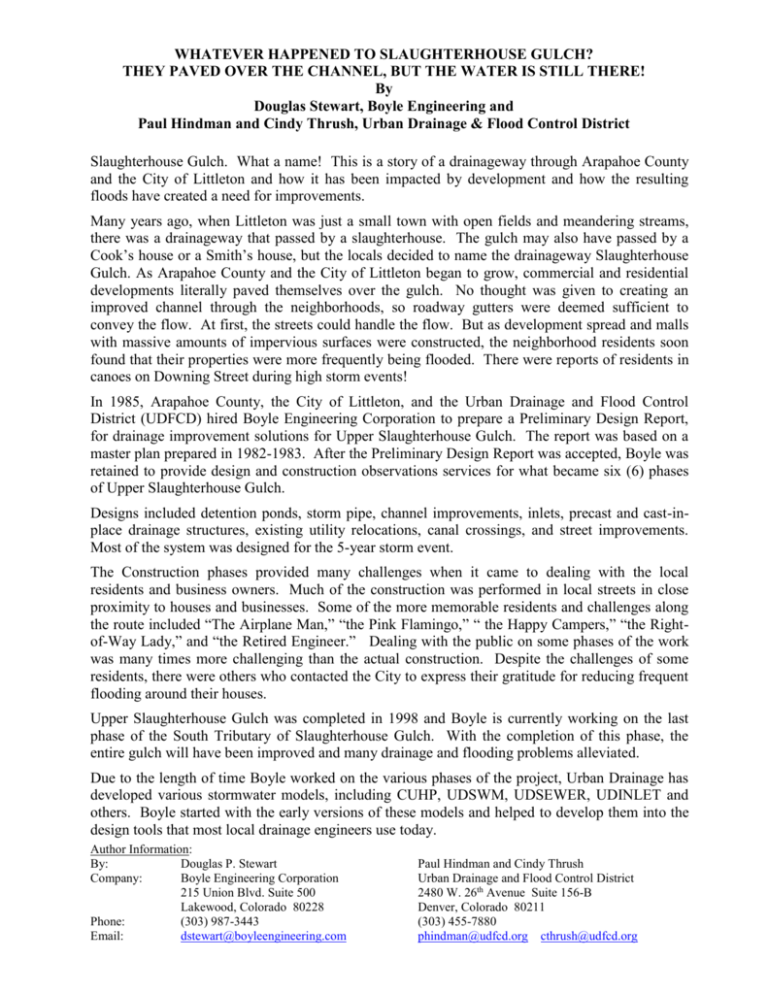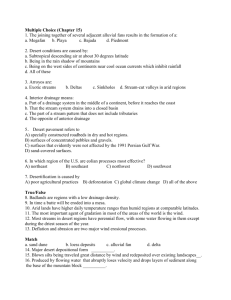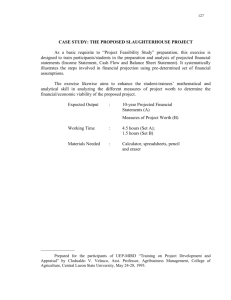whatever happened to slaughterhouse gulch? they paved over the
advertisement

WHATEVER HAPPENED TO SLAUGHTERHOUSE GULCH? THEY PAVED OVER THE CHANNEL, BUT THE WATER IS STILL THERE! By Douglas Stewart, Boyle Engineering and Paul Hindman and Cindy Thrush, Urban Drainage & Flood Control District Slaughterhouse Gulch. What a name! This is a story of a drainageway through Arapahoe County and the City of Littleton and how it has been impacted by development and how the resulting floods have created a need for improvements. Many years ago, when Littleton was just a small town with open fields and meandering streams, there was a drainageway that passed by a slaughterhouse. The gulch may also have passed by a Cook’s house or a Smith’s house, but the locals decided to name the drainageway Slaughterhouse Gulch. As Arapahoe County and the City of Littleton began to grow, commercial and residential developments literally paved themselves over the gulch. No thought was given to creating an improved channel through the neighborhoods, so roadway gutters were deemed sufficient to convey the flow. At first, the streets could handle the flow. But as development spread and malls with massive amounts of impervious surfaces were constructed, the neighborhood residents soon found that their properties were more frequently being flooded. There were reports of residents in canoes on Downing Street during high storm events! In 1985, Arapahoe County, the City of Littleton, and the Urban Drainage and Flood Control District (UDFCD) hired Boyle Engineering Corporation to prepare a Preliminary Design Report, for drainage improvement solutions for Upper Slaughterhouse Gulch. The report was based on a master plan prepared in 1982-1983. After the Preliminary Design Report was accepted, Boyle was retained to provide design and construction observations services for what became six (6) phases of Upper Slaughterhouse Gulch. Designs included detention ponds, storm pipe, channel improvements, inlets, precast and cast-inplace drainage structures, existing utility relocations, canal crossings, and street improvements. Most of the system was designed for the 5-year storm event. The Construction phases provided many challenges when it came to dealing with the local residents and business owners. Much of the construction was performed in local streets in close proximity to houses and businesses. Some of the more memorable residents and challenges along the route included “The Airplane Man,” “the Pink Flamingo,” “ the Happy Campers,” “the Rightof-Way Lady,” and “the Retired Engineer.” Dealing with the public on some phases of the work was many times more challenging than the actual construction. Despite the challenges of some residents, there were others who contacted the City to express their gratitude for reducing frequent flooding around their houses. Upper Slaughterhouse Gulch was completed in 1998 and Boyle is currently working on the last phase of the South Tributary of Slaughterhouse Gulch. With the completion of this phase, the entire gulch will have been improved and many drainage and flooding problems alleviated. Due to the length of time Boyle worked on the various phases of the project, Urban Drainage has developed various stormwater models, including CUHP, UDSWM, UDSEWER, UDINLET and others. Boyle started with the early versions of these models and helped to develop them into the design tools that most local drainage engineers use today. Author Information: By: Douglas P. Stewart Company: Boyle Engineering Corporation 215 Union Blvd. Suite 500 Lakewood, Colorado 80228 Phone: (303) 987-3443 Email: dstewart@boyleengineering.com Paul Hindman and Cindy Thrush Urban Drainage and Flood Control District 2480 W. 26th Avenue Suite 156-B Denver, Colorado 80211 (303) 455-7880 phindman@udfcd.org cthrush@udfcd.org









